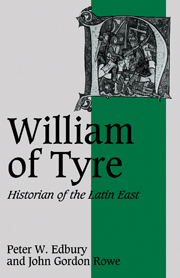Introduction
Published online by Cambridge University Press: 09 October 2009
Summary
Historians are unanimous: the work by William II, archbishop of Tyre, which until recently has been known as the Historia rerum in partibus transmarinis gestarum, but which might better be entitled Historia Ierosolymitana, is important and influential. William flourished in the kingdom of Jerusalem during the reigns of King Amaury (1163–74) and his son, Baldwin IV (1174–85), and he provided the Latin kingdom with an account of its foundation and history, spanning the period from the preaching of the First Crusade in 1095 until the year 1184. The Historia begins with a brief survey of the background to the First Crusade, going back to the recovery of the True Cross by the Byzantine emperor Heraclius early in the seventh century, before proceeding to recount the story of the Crusade (Books I–VIII) and the fortunes of the Latins in the lands they conquered (Books IX–XXIII). It is a long work: in the most recent edition William's Latin text fills just under a thousand pages. Its very size makes it difficult to view as a whole, and for this reason scholars have been far more ready to use it as a quarry for historical information than to try to assess its strengths and weaknesses as an example of twelfth-century historiography or to seek to examine the presuppositions and attitudes of its author. As a quarry for historical information it has long been recognized as being of the utmost importance.
- Type
- Chapter
- Information
- William of TyreHistorian of the Latin East, pp. 1 - 10Publisher: Cambridge University PressPrint publication year: 1988

